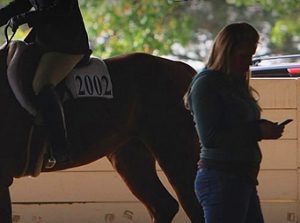Don’t Worry, Be Happy! – Civility Between Former Clients & Trainers
Click here to read the complete article116 – January/February 2019
By Delores Kuhlwein
 Unfortunately, splits between a trainer and client in the horse industry can be as messy as a bad divorce. To make matters more challenging, you likely run in the same circles and will frequently encounter each other at horse shows. So how can both trainer and client cope with this dilemma? It might not be easy, but the aftermath of a departure doesn’t have to be unpleasant, according to experienced amateurs and trainers.
Unfortunately, splits between a trainer and client in the horse industry can be as messy as a bad divorce. To make matters more challenging, you likely run in the same circles and will frequently encounter each other at horse shows. So how can both trainer and client cope with this dilemma? It might not be easy, but the aftermath of a departure doesn’t have to be unpleasant, according to experienced amateurs and trainers.
Follow along as we break down the barriers of an off-limits topic, reveal the best strategies for diffusing tension and eliminating stress well before the show, and offer tried-and-true methods of handling an awkward chance meeting on the showgrounds.
Communication is Priceless
According to some well-versed horse enthusiasts, one secret to having a congenial parting of ways, or perhaps never having it in the first place, begins before the split ever occurs. That key is communication. While open communication is good for the health of any relationship, it’s sometimes easier said than done when so much is at stake, both emotionally and financially. But just like showing horses, practice makes perfect, and applying this technique is always a good idea.
Jason and Terri Contreras of C and C Performance Horses located in Sanger, California, try to talk openly to their clients on an ongoing basis, particularly regarding whether the horse they own will reach their goals. “I’ve seen a lot of people spend a lot of money and then leave their trainers because they aren’t winning. We try to be as realistic with people as we possibly can be and have a decent relationship with them in the first place,” Terri Contreras explains.
Likewise, amateur exhibitor Anita Wiescamp of Quitman, Texas, says communication throughout the relationship is huge and that responsibility lies with both the trainer and client to talk to each other, since both are part of a team with common goals. “Ask questions, be informed, and stay focused as a team. Be honest, and if you have a problem with your trainer or things change, talk to them about it. Get the problem on the table and hash it out,” she advises.
Wiescamp explains that the trainer is the person who should hear about any problem firsthand. “Don’t sneak around and hope your trainer finds out that something is wrong from someone else, because the third party will add their take on the problem to compound it. Part of your responsibility is not letting other team members get blindsided. Nothing is better than good honest communication when there is a problem,” she says.
Click here to read the complete article116 – January/February 2019










